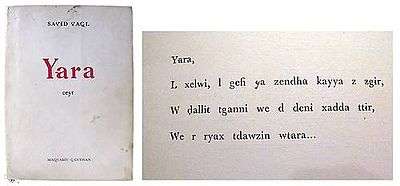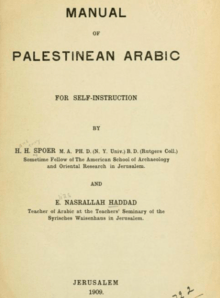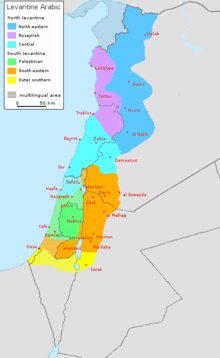Levantine Arabic
| Levantine Arabic | |
|---|---|
| Eastern Arabic | |
| لهجات شامية | |
| Native to | Levant, Cyprus |
Native speakers | (21 million cited 1991–1996)[1] |
|
Afro-Asiatic
| |
| Arabic alphabet | |
| Language codes | |
| ISO 639-3 |
Variously: apc – North Levantine ajp – South Levantine acy – Cypriot Arabic |
| Glottolog |
leva1239[2] |
|
Mainland Levantine Arabic | |
Levantine Arabic (Arabic: اللهجة الشامية, al-lahjah aš-šāmiyyah) is a broad dialect of Arabic spoken in the 100 to 200 km-wide Eastern Mediterranean coastal strip.[3] It is considered one of the five major varieties of Arabic.[4] In the frame of the general diglossia status of the Arab world, Levantine Arabic is used for daily spoken use, while most of the written and official documents and media use Modern Standard Arabic. It is part of Eastern Arabic (known as Mashriqi Arabic) that includes Mesopotamian Arabic and peninsular Arabic along with Levantine.
Generalities
Location
Levantine Arabic is spoken in the fertile strip on the eastern shores of the Mediterranean. To the East, in the desert, one finds North Arabian Bedouin varieties. The transition to Egyptian Arabic in the South via the Negev and Sinai desert where Bedouin varieties are spoken and then the Egyptian Sharqiyya dialect, was described by de Jong in 1999,.[5] In this direction, the Egyptian city of El Arish is the last one to display proper Levantine features. In a similar manner, the region of el-Karak announces Hijazi Arabic.[6] In the North, the limit between Mesopotamian Gilit dialects starts from the Turkish border near el-Rāʿi, and the lake Jabbul is the north-eastern limit of Levantine Arabic, which includes further south el-Qaryatayn [7] Damascus and the Hauran mountains.
Main features
The most distinctive feature of Levantine Arabic is probably its stress pattern, which remains closest to the Classical Arabic among all varieties. It ignores the gahawa syndrome typical of the Mesopotamian and Peninsular Arabic (/ˈqahwa/ > /ɡaˈhawa/); it does not shift the stress away from a heavy antepenultimate syllable, as does Egyptian Arabic (/ˈmadrasa/ > /madˈrasa/); and it is foreign to the North African stress shift to the last syllable (/baħr/ > /bħar/, /ˈmarʔa/ > /mra/). An important feature is the pronunciation of qāf, which is usually reduced to a glottal stop (/ˈqahwa/ > /ʔaˈhwe/) except in the southernmost part (Gaza, Beersheva, el-Karak). Another distinctive feature is the use of a prefixed b- in the imperfect to distinguish the indicative mood (with b-) from the subjunctive mood (without b-), e.g. /ˈbtɪʃrab/ 'you drink' vs. /ˈtɪʃrab/ 'that you drink'.
Origin
The area where Levantine Arabic is spoken has historically been home to other Semitic speakers for millennia, with written records beginning with the Eblaite, then Ugaritic and Canaanite languages such as Moabite, Ammonite, Hebrew, and Phoenician. The Canaanite languages had the characteristic feature of shifting common Semitic /ā/ to /ō/, /ð/ to /z/ and /θ/ to /š/, and showed a characteristic unbroken masculine plural in /-iːm/.
By the middle of the 1st millennium BCE, Western Aramaic had come to dominate most of the region and was subsequently strengthened by its use as an official language of the Persian Empire. Persian influence declined after Alexander the Great conquered the area, which was subsequently annexed by the Romans several centuries later. Having been a part of the more Hellenized Eastern Roman Empire, just before Arabisation, the region counted a significant number of Greek speakers as a province of the Byzantine Empire.
Since Roman times, Arabic was a neighboring language, spoken in the desert immediately east of this area (Nabataeans in Petra and the Negev). The Ghassanid kingdom established in the first centuries CE in the Hauran mountains was the first (Christian) Arab authority on the sedentary area. In the first years of the Islamic conquest, the Levant was taken from the Byzantine Empire and the first Caliphate was established in Damascus. Arabic entered deeper into the population by then, although the shift occurred gradually. The persistence of a spoken Aramaic dialect in a few villages to the north of Damascus is the last trace of this slow conversion. It is interesting to note that this Aramaic dialect shares feature with rural Palestinian Arabic (e.g. /q/ > /k/).
It may thus be considered that Levantine Arabic arose from the adoption of Arabic by speakers of Aramaic languages which resulted in a marked Aramaic substrate. The state of affairs in Aramaic immediately before Arabization is largely unknown, but it could have shown dialectal variations linked to the languages Aramaic replaced (as it did rapidly so), and this may have left traces in the subsequent Arabic dialects. See, for example, the similarity of central Palestinian plural suffix pronouns (-kem, -ken, -hem, -hen) with their Hebrew counterparts, or the variant of the same pronouns in the Nusairiyyah mountains (-ko:n, -ke:n, -ho:n, -he:n) compared to identical forms in Aramaic. In other words, the implication is that there is an Aramaic substrate in Levantine Arabic, but the Aramaic of some regions already included strong substrates of preceding languages (e.g. Hebrew in Palestine). These influenced Levantine Arabic via Aramaic, although they had themselves long been out of use at the time of the Arabisation.
It is likely that the Arabic they adopted is a Hijazi (as opposed to Najdi spoken by Bedouins) variety of Arabic (as shown, for example, by the treatment of an internal glottal stop as a semivowel).
Varieties and Phonology
Grammar
For Modern Standard and Classical Arabic grammar, see Arabic grammar.
Morphology
Personal pronouns
In Levantine Arabic, personal pronouns can have anything between eight and twelve forms depending on various locational and social factors: The second and third persons differentiate gender, while the first person does not, although many Levantine Arabic variants (especially urban varieties) have not preserved gender in the plural whatsoever. Most variants of Levantine Arabic have lost the dual number. Traditionally, the pronouns are listed in the order "third, second, first".
| Person | Common form | Arabic Script | Variants |
|---|---|---|---|
| 1 p. sing. I | 'ana | أنا | 'ane (Nablus Samaritans) |
| 2 p. sing. masc thou" | 'ɪnte | انتَ | ɪnᵊt (rural Palestinian, Lebanese) |
| 2 p. sing. fem. | 'ɪnti | انتِ | ɪnᵊt (rural Palestinian, Lebanese) |
| 3 p. sing. masc. | 'huwwe | هو | hu:we (Syrian, Lebanese), hu: (rural Palestinian, Hauran), hu (as short, unstressed form) |
| 3 p. sing. fem. | 'hiyye | هي | hi:ye (Syrian, Lebanese), hi: (rural Palestinian, Hauran), hi (as short, unstressed form) |
| 1 p. plur. | 'nɪħna | نحن | 'ɪħna (West Bank, Gaza, Jaffa, Jordan, Syrian Hauran), 'nɪħne (Nablus Samaritans) |
| 2 p. plur. masc. | 'ɪntu | انتم | 'ɪntu (in most cities) |
| 2 p. plur. fem. | 'ɪntɪn | انتن | 'ɪntu (in most cities) |
| 3 p. plur. masc. | 'hʊmme | هم | 'hʊmme (Jerusalem, Jaffa, Amman), 'hənne (Damascus), 'hʊm (Hauran, West Bank) |
| 3 p. plur. fem. | 'hɪnne | هن | 'hɪnne (Lebanon), 'hənne (Damascus), 'hɪn (Hauran, West Bank) |
The trend in the most evolutive variants (i.e. urban) is to lose the distinction between masculine and feminine in the plural. The result is an alignment on the masculine for both genders, but the feminine variant remains understood.
Enclitic pronouns
Enclitic forms of personal pronouns (الضمائر المتصلة aḍ-ḍamāʾir al-muttaṣilah) are affixed to various parts of speech, with varying meanings:
- To the construct state of nouns, where they have the meaning of possessive demonstratives, e.g. "my, your, his"
- To verbs, where they have the meaning of direct object pronouns, e.g. "me, you, her"
- To prepositions, where they have the meaning of objects of the prepositions, e.g. "to me, to you, to him"
- To conjunctions and particles, e.g. "because I, because you, because she"
| Person | Common form | Arabic script | variants |
|---|---|---|---|
| 1 p. sing. I | -i / -iyye (-ni after verbs) | (ـي (ـنـي | |
| 2 p. sing. masc thou" | -ak / -k | ـَك | -ek (Lebanese) |
| 2 p. sing. fem. | -ɪk / -ki | ـِك | |
| 3 p. sing. masc. | -ʰʊ / -ʰ | ـه | -ʰa / -ʰ (Central West Bank) |
| 3 p. sing. fem. | -ʰa / -ha | ـها | -he (Nablus Samaritans) |
| 1 p. plur. | -na / -na | ـنا | -ne (Nablus Samaritans) |
| 2 p. plur. masc. | -kʊm | ـكم | -kʊn (Syrian, Lebanese), -ku (Galilee, Hebron), -kɪm (West Bank) |
| 2 p. plur. fem. | -kɪn | ـكن | -kʊn (Syrian, Lebanese), -ku (Galilee, Hebron), -kʊm (Jerusalem, Jaffa) |
| 3 p. plur. masc. | -ʰʊm / -hʊm | ـهم | -ʰʊn / -hʊn (Lebanese, Syrian), -ʰɪn/-hɪn (Galilee) |
| 3 p. plur. fem. | -ʰɪn/-hɪn | ـهن | -ʰʊm / -hʊm (Jerusalem, Jaffa, Amman), -ʰʊn / -hʊn (Lebanese, Syrian) |
Attempts at institutionalisation
 Lebanon has been passing through trials of setting up the Lebanese Language. LEBNAAN Newspaper in proposed Said Akl alphabet (issue #686)
Lebanon has been passing through trials of setting up the Lebanese Language. LEBNAAN Newspaper in proposed Said Akl alphabet (issue #686)
 Manual of Palestinean Arabic, for self-instruction 1909
Manual of Palestinean Arabic, for self-instruction 1909
See also
References
- ↑ North Levantine at Ethnologue (18th ed., 2015)
South Levantine at Ethnologue (18th ed., 2015)
Cypriot Arabic at Ethnologue (18th ed., 2015) - ↑ Hammarström, Harald; Forkel, Robert; Haspelmath, Martin; Bank, Sebastian, eds. (2016). "Levantine Arabic". Glottolog 2.7. Jena: Max Planck Institute for the Science of Human History.
- ↑ Versteegh, Kees, The Arabic language, Edinburgh University Press, 2001, p.170
- ↑ Bassiouney, Reem, Arabic sociolinguistics, Edinburgh University Press, 2009, p.20
- ↑ Rudolf de Jong, Characteristics of Bedouin dialects in southern Sinai: preliminary observations, in, Manfred Woidich, Martine Haak, Rudolf Erik de Jong,, eds., Approaches to Arabic dialects: a collection of articles presented to Manfred Woidich on the occasion of his sixtieth birthday, BRILL, 2004, pp.151-176
- ↑ Heikki Palva, Sedentary and Bedouin Dialects in Contact: Remarks On Karaki and Salti Dialects in Jordan, Journal of Arabic and Islamic Studies vol 9 (2008)
- ↑ Peter Behnstedt, Sprachatlas von Syrien I, Kartenband & Beiheft, Wiesbaden: Harrassowitz, 1997, 1037 & 242 pages
Bibliography
- A. Barthelemy, Dictionnaire Arabe-Français. Dialectes de Syrie: Alep, Damas, Liban, Jérusalem (Paris, 1935)
External links
| Levantine Arabic test of North Levantine Arabic at Wikimedia Incubator |
| Levantine Arabic test of South Levantine Arabic at Wikimedia Incubator |
- Lebanese Levantine Arabic
- Syrian Levantine Arabic
- http://lughat.blogspot.com/2014/09/why-levantine-is-arabic-not-aramaic.html
- http://lughat.blogspot.com/2014/09/why-levantine-is-arabic-not-aramaic_8.html
